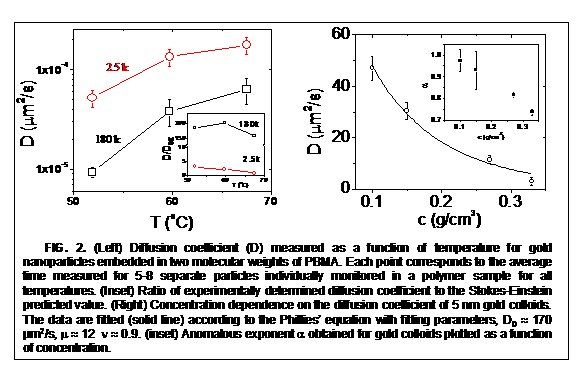Reports: G5
44953-G5 Direct Measurement of Casimir Force in Critical Films of Binary Liquid Mixtures
The support from
the ACS-PRF grant has resulted in five publications so far. These include
papers in Physical Review Letters, Applied Physical Letters, and a book
chapter. Another manuscript has been submitted to Physical Review Letters
recently. My first student, Chris Grabowski has completed his Ph. D in March,
2009 and currently a post doctoral research associate at the Liquid Crystal
Institute, We continued
our experiments in measuring the critical Casimir force
of a binary liquid mixture using a home-built atomic force microscope (AFM). We
still need to solve several technical problems to obtain reliable data. The
temperature stability for the set-up at present is 50 mK/hr
and needs to be improved by at least a factor of ten to make the proposed experiments
possible. There is also an issue of the detachment of the microsphere
from the cantilever. The sphere needs to be fixed in place for at least few
hours, but the organic mixtures used for the experiments dissolve the
glue, which is holding the sphere. Currently,
we are searching for better glues which can overcome this problem.
Critical Casmir force is expected to play role in
the reversible colloidal flocculation near the phase transition temperature of
a binary mixture. As the overlap of the order parameter profile on the
particles is essential for the occurrence of this force, we performed experiments,
which elucidate the effect of surface curvature on critical adsorption. The
method we used was fluorescence correlation spectroscopy (FCS). The temperature
dependence of the adsorbed film thickness and excess adsorption were determined
by measuring the enlarged effective hydrodynamic radius of spherical nanoparticles immersed in a critical binary solvent of 2,6 lutidine + water. Our results indicated that the adsorbed
film thickness is of the order of correlation length and the excess adsorption
per unit area increases following a power law in reduced temperature with an
exponent of -1. This has been confirmed with silica particles of two different
radii, 10 nm and 25 nm. The results were also compared with theoretical mean
field scaling function (Fig 1). We submitted the results of this work to
Physical Review Letters.
We
have also studied the diffusion of gold nanoparticles
in semidilute and entangled solutions of polystyrene
(PS) in toluene using FCS. The polymer concentration was varied from ~ 6c*
to 20c*, where c* is the overlap concentration. In
our experiments the particle radius (R » 2.5 nm)
was much smaller compared to the radius of gyration (Rg
» 18 nm) of the chain but
comparable to the average mesh size (x) of the
fluctuating polymer network. The diffusion coefficient (D) of the particles
decreased monotonically with polymer concentration and it can be fitted with a
stretched exponential function, D =D0 exp (-mcν), with
the value of the scaling parameter, ν » 0.9. At
high concentration of the polymer, a clear subdiffusive
motion of the particles was observed (Fig. 2). The results were compared with the
diffusion of free dyes (coumarin 480), which showed normal diffusive behavior for all concentrations.
 In other research, we
have used gold nanoparticles as a luminescent
contrast agent to study size-dependent dynamics in polymer matrix. The
experiments measured the diffusion coefficient of particles in poly(butyl methacrylate) melt by
tracking their motion within a diffraction-limited focus of a laser with 150 fsec pulses at 800 nm. Our results indicate that for unentangled polymers, when the particle radius (R) is
greater than the gyration radius (Rg) of
the chain, the Stokes-Einstein relation can accurately predict particle
dynamics. For longer chains, if the entanglement mesh length is larger than R,
the particle diffuses ~250 times faster than predicted by the Stokes-Einstein
relation (Fig. 2). The article that we published in the Applied Physics Letters
has been selected for the February 2009 issue of
Virtual Journal of Ultrafast Science.
In other research, we
have used gold nanoparticles as a luminescent
contrast agent to study size-dependent dynamics in polymer matrix. The
experiments measured the diffusion coefficient of particles in poly(butyl methacrylate) melt by
tracking their motion within a diffraction-limited focus of a laser with 150 fsec pulses at 800 nm. Our results indicate that for unentangled polymers, when the particle radius (R) is
greater than the gyration radius (Rg) of
the chain, the Stokes-Einstein relation can accurately predict particle
dynamics. For longer chains, if the entanglement mesh length is larger than R,
the particle diffuses ~250 times faster than predicted by the Stokes-Einstein
relation (Fig. 2). The article that we published in the Applied Physics Letters
has been selected for the February 2009 issue of
Virtual Journal of Ultrafast Science.





